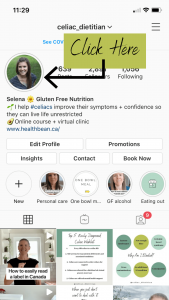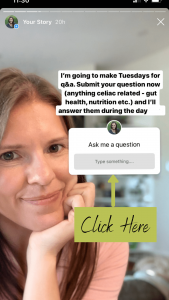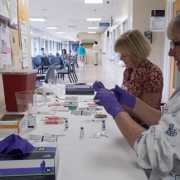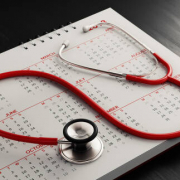3 Reasons You May Feel Tired on the Gluten-Free Diet by Selena De Vries, RD
Basic pillars of nutritional health and lab parameters can resolve the symptoms of fatigue that many celiacs experience.

- Selena De Vries is dedicated to helping individuals who are struggling with digestive issues find food freedom. Selena understands that celiac disease not only effects one’s physical health but also effects one’s emotional health. Using an integrative approach in the management of digestive health conditions, she provides support for those with celiac disease/gluten sensitivity and nutrition coaching for other digestive health conditions.
Get Selena’s Top 21 Simple and Energizing, Gluten Free Snack Ideas
_____
 Fatigue is probably the most common complaint I get when seeing clients with celiac disease. Often, individuals jump to thinking they need some complex supplement, an exclusion diet trial to discover food sensitivities, or specialized lab testing. But, it often comes down to a few basic pillars of nutritional health and lab parameters. Let’s discuss them below.
Fatigue is probably the most common complaint I get when seeing clients with celiac disease. Often, individuals jump to thinking they need some complex supplement, an exclusion diet trial to discover food sensitivities, or specialized lab testing. But, it often comes down to a few basic pillars of nutritional health and lab parameters. Let’s discuss them below.
1. Lack of fiber and protein in the diet
This is by far, very common in not only individuals with celiac disease, but the general population. Protein and fiber helps to hold blood sugars stable, which is one thing that contributes to energy levels. Stable blood sugar = stable and consistent energy levels.
Often times, many people forget to include protein at breakfast and lunch and load up with a giant steak or chicken breast at dinner. Without adequate protein earlier in the day, energy levels will falter and you’ll be finding yourself wanting to take a snooze instead of being productive!
In terms of fiber, many people also don’t get enough. The average Canadian gets ~10-15g of fiber per day. The recommended amount is 25-38g per day. In individuals with celiac disease, a low fiber diet is even more common as celiacs tend to eat a lot of white rice products (low fiber) and other grains and products made with low fiber grains and starchs such as cereals, breads, pastas and bars.
Without consistent fiber intake at meals and snacks, blood sugars will be more likely to up and down vs stable which will contribute to uneven energy levels.
Check out this breakfast post which includes ways to revamp your gluten free breakfast.
2. Skipping meals and/or meals that are not nutritionally balanced
Most people need 3 meals/day and, perhaps, 1 snack especially if you are someone that goes more than 5 hours between meals. Going without food for a long period of time may also contribute to uneven blood sugars which will have a negative effect on energy levels. Sometimes, people go so long without eating and mention to me that they have no problems going so long without food. But then once they eat, they find themselves gorging on food because they all of a sudden are STARVING and seem constantly hungry. This is your hunger hormone, ghrelin, at work. The longer your stomach is empty (ie- the longer you go without eating), the more of this hormone is secreted by your stomach. The higher your levels, the hungrier you get and it will be a, purely, biological drive to eat to satisfy that hunger. As you can imagine, eating a large amount of food in one sitting is most definitely going to make you feel lethargic.
In addition, if your meals aren’t balanced, it may also make it difficult to stabilize your energy levels. This has a lot to do with consistent and adequate fiber and protein at meals, which is discussed above.
3. Low lab parameters
Individuals with celiac disease are at higher risk for nutritional deficiencies as well as other autoimmune conditions that can contribute to fatigue. So, as a rule of thumb it is good to rule these out:
- Hashimotos (or autoimmune thyroid disease). You can test for this condition with your doctor by looking at TSH, thyroid antibodies and additional parameters such as T3 and T4.
- Iron deficiency anemia or low iron. Your doctor can order this test by ordering a CBC and ferritin level.
- Low B12 levels. This is another type of anemia and your doctor can order this test by ordering a B12 level.
- Low copper. This should be tested when iron levels are unresponsive to iron supplementation. Your doctor would order a copper level.
What to Eat for Improved Energy Levels:
- Aim for 3 meals per day and snacks so that you are going no longer than about 5 hours without eating.
- Aim for 7-10g of fiber at each meal. In order to achieve this, aim to make half your plate vegetables, 1/4 plate whole grains or fruit and 1/4 plate protein (choosing beans/legumes or nuts/seeds often for your protein choice).
- Include ~15g of protein at breakfast, and 20-30g of protein at lunch and dinner.
- Address low lab parameters individually with your medical doctor or dietitian.
Good Sources of Fiber:
- Fruit, especially oranges, berries, apples, and pears
- Vegetables, especially leafy greens, avocado, green beans, carrots and cruciferous veggies
- Whole grains including GF oats, brown rice, teff, millet, quinoa and buckwheat
- Beans and legumes including lentils, chickpeas, black beans, white beans, edamame beans, tofu, tempeh, ‘noodles’ or ‘rice’ made from beans etc.
- Ground flax, psyllium husk and chia seeds
Good Sources of Protein:
- Hemp hearts, almonds, cashews, sunflower seeds and other nuts and seeds
- Beans and legumes including lentils, chickpeas, black beans, white beans, edamame beans, tofu, tempeh, ‘noodles’ or ‘rice’ made from beans etc.
- Yogurt, cheese, cottage cheese, cows milk, soy milk
- Eggs, chicken, turkey, salmon, beef, moose, duck etc.
Sample Day of a Energy Boosting Diet:
- 7am: 1/2 cup GF large flakes oats, cooked, topped with 1/4 cup walnuts, 1 TBP ground flax, a handful of blueberries, topped with some yogurt/cream (optional) and a drizzle of maple syrup and shake of cinnamon.
- Fiber = 11g; Protein = 13g
- 12pm: 3/4 cup cooked quinoa, tossed with 1/2 cup cooked edamame, 1/4 cup chopped cucumber, 1/4 cup chopped cherry tomatoes, 3 TBP feta cheese, 1 cup spinach, tossed with your favourite salad dressing.
- Fiber = 13g; Protein 22g
- 4pm: apple
- Fiber = 4g
- 6:30pm: 4-5oz salmon with maple seasoning, 1/2 cup roasted sweet potato, 1 cup roasted broccoli, 1 sliced orange
- Fiber 10g; Protein = 28g
Total Fiber for the day 38g; Protein 63g
SOURCE ARTICLE: http://www.healthbean.ca/3-reasons-why-you-may-feel-tired-on-the-gf-diet/
 I’m Selena – THE CELIAC DIETITIAN
I’m Selena – THE CELIAC DIETITIAN
I operate an online private practice specializing in the dietary management of celiac disease and the gluten free diet. And, I’m celiac too.
As the go-to expert on everything gluten free, I help people master the gluten-free diet so they can live gluten free with more ease.
I take the ‘complicated’ out of the gluten free diet, and give you the practical and realistic advice you need so you can still live your life!
• SelenaRD.com • About Selena • Instagram • Facebook • Selena’s Blog
• Book a call with Selena
• Receive Selena’s Free 3-Step Guide to Label Reading Guide
• Media – Work with Selena
‘Q&A Tuesdays on Instagram’
Your chance to submit any questions you may have on nutrition, education or receive downright free advice! Fellow celiac and expert Gluten-Free Dietitian, Selena De Vries, RD, is eager to help! Ask by 4pm Pacific Time and get your answer the same day!
How it works!
1. Visit Selena’s profile at https://www.instagram.com/celiac_dietitian/
2. Click on her profile picture (screenshot 1)
3. Wait until you see the “ask me a question” sticker and then click it and type your question (screenshot 2)
4. Receive your answer by clicking through Selena’s stories i.e. the same spot where you entered your question
- Does it feel like celiac disease is taking over your life?
- Do you want a solution that makes celiac feel less overwhelming and less stressful so you can get back to living and loving your life?
- Are you thinking about celiac from the time you wake up, to the time you go to bed?
- Are you worried about cross contact? ,
- Does eating out feel frustrating?
- Are you experiencing persistent symptoms?
- Does celiac disease often creep into your thoughts?
Well, no more. You’re in the right place now. And, it’s time for this to change!
 Selena’s Services
Selena’s Services
Live Gluten Free with More Ease – Hybrid Group Program – Master the Gluten Free Diet
This online program combines 1:1 support and group coaching support. Sky rocket your knowledge beyond what most healthcare providers know and kick anxiety and stress to the curb. This hybrid program is the ultimate, A-Z, course that will help you live gluten free with more ease.
Learn more
Apply now
 Eat Out with Confidence – Group Coaching – Become a Celiac Savvy Restaurant Diner
Eat Out with Confidence – Group Coaching – Become a Celiac Savvy Restaurant Diner
If you find yourself avoiding eating out because of anxiety around cross contact, not knowing the right questions to ask, or not trusting that the staff are taking you seriously, then this online, group coaching course is for you.
Learn more
Apply now
 1:1 Individual Coaching – Receive an Individualized Action Plan
1:1 Individual Coaching – Receive an Individualized Action Plan
This online service is best suited to help people find relief of persistent symptoms such bloat, constipation, reflux, or fatigue. It is also helpful for newly diagnosed and people who prefer to work, solely, in a 1:1 capacity.
Learn more
Apply here
















